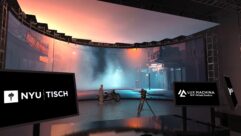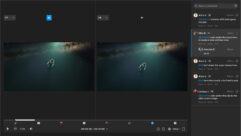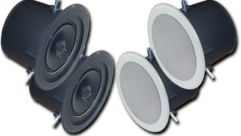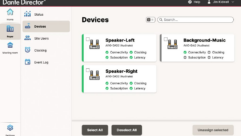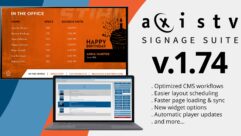

Sign of the Times
When all was said and done, show organizers said attendance at late February’s Digital Signage Expo (DSE) in Las Vegas was up 70 percent over the previous year. Dave Leonard, project manager at the World Bank in Washington, D.C., was there.
NEC TileMatrix Video Wall
When all was said and done, show organizers said attendance at late February’s Digital Signage Expo (DSE) in Las Vegas was up 70 percent over the previous year. Dave Leonard, project manager at the World Bank in Washington, D.C., was there.
“We have an existing digital signage system that dates to about 2003,” says Leonard, who is responsible for AV systems at the World Bank. “It’s used mostly as a reader board for daily meetings and events, but also for electronic posters.”
As a first-time attendee, Leonard was on the lookout for certain technology. “The hardware and network are pretty straightforward,” he explains. “The software is most intriguing, especially as it relates to content creation and management. For us, the system has to stay very current, so the software has to automatically talk to other applications in the enterprise and draw data from those apps. Then it has to organize and display that content in an attractive and temporally appropriate way.”
Powerful signage software was just one of the discoveries Leonard and others made at DSE. All-in-one solutions and innovative products tailored specifically for digital signage applications were also prevalent. Here are some of the new technologies AV professional should keep an eye on.
Omnivex Moxie. Moxie is a new software platform designed to meet rising expectations for richer and more relevant content on display screens, say company officials. It’s built on the same 3D graphics engine found in Microsoft Windows Vista and high-end video games. Graphics created in Moxie are scalable, meaning one design fits many screen resolutions, which should cut the cost of optimizing graphics for different displays.
In addition, graphics managed through Moxie—including individual components of a larger graphical display—can be linked to dynamic data so that changes occur on-the-fly at the media player location without designer involvement. For example, a digital sign in an airport terminal can display departure times in larger or more eye-catching fonts as those times get closer. (www.omnivex.com)
C-nario Advertiser 4.1. The latest version of C-nario’s software-based distribution, display, control, and management system is geared for advertising in targeted environments. Ideally suited to media companies, Advertiser 4.1 includes Web-based asset management, which allows advertisers and customers to manage content from anywhere. As an advertising platform, it offers the necessary high level of reporting and proof-of-play capabilities so clients know their messages are being displayed. Through a single interface, managers can see what’s showing on an entire network of screens. A smart scheduling engine automatically generates unlimited numbers of explicit play lists, assigning each list to selected sites. (www.c-nario.com)
NEC TileMatrix Video Wall. NEC Display Solutions’s new pre-configured hardware/software solution is designed to get installers and small companies started with videowall technology. Composed of four NEC 46-inch MultiSync LCD4620-2-IT displays, the system uses NEC’s TileMatrix technology, which enables videowalls of up to 25 displays (5×5) using one video source, thereby cutting down the need for splitters and distribution amplifiers or for connecting monitors to multiple sources.
The 16.5-millimeter bezels are already thing, but NEC adds a feature called TileComp that helps seamlessly smooth out images as they move across screens. The complete package, which has an MSRP of $19,000, includes Digital Factory mounting, Extron cables, and a Tripp Lite surge suppressor. It is RoHS (Restriction on Hazardous Substances) compliant.
NEC also rolled out an $8,000 Lobby Signage Solution, which comes with a 40-inch NEC AccuSync PV40 display, mounting hardware, PC hardware, content management software, and power suppression. The all-in-one system is aimed at small and first-time digital signage solutions. (www.necdisplay.com)
3M and NextWindow touch screens. 3M’s MicroTouch Dispersive Signal Technology (DST) touch screens come in 32-, 40-, 42-, and 46-inch sizes. Whereas traditional touch technologies often detect a person’s touch when it interrupts acoustic waves, optical fields, or infrared beams above the surface of the screen, DST calculates touch locations by analyzing bending waves in the glass substrate. The company says DST is ideal for signage applications because it’s unaffected by on-screen contaminants and moderate surface damage. (www.3m.com)
NextWindow 2400 Series Screen Overlays and 2100 Touch Screen Kits were on display at DSE in demonstrations by NEC, Electrograph, Ingram Micro, and others. Both use the company’s proprietary optical touch technology to turn large, flat-screen monitors into interactive touch screens. The overlays, which incorporate two optical sensors at the corners, use an industry-standard USB interface, so to the computer system, they appear as just another input device. (www.nextwindow.com)
Peerless Video Wall Mount. The new VWP-4050-B supports screens from 40 to 50 inches. It allows for any number or style of video wall matrices, and its scissor-style arm means installers can access any screen in the matrix without dismantling the surrounding screens. (www.peerlessmounts.com)


